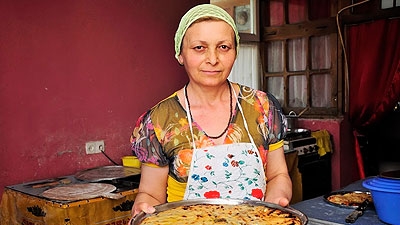Moving from State Dependency to Self-Support
Like Manjavidze, three other IDPs – Soso Meskhia, Galina Okropiridze, and Jason Turashvili –also have their own experiences of both challenges and successes of being in such a situation.
Turashvili heads an agriculture machinery group in Shavshvebi, where he settled with his family after the 2008 South Ossetia conflict. Developing a business plan and winning a small grant provided by a non-governmental organization was a challenge, but Turashvili and his team were lucky to get and use the grant to buy the necessary machinery and start working.
“Of course we don’t want to be dependent on someone else,” said Turashvili. “We have plans for the future. The displacement has created serious challenges for all of us. But if we can receive funds to buy equipment for our businesses, we could become independent.”
Not all IDPs manage to formulate successful business plans, and available grants are not always enough to help all IDPs. Therefore, there is an immediate need for new strategies and approaches to find durable solutions to IDPs’ living conditions, to reach all IDPs, to benefit Georgia as a whole.
A World Bank review of current practices and lessons learned from supporting the livelihoods of IDPs in Georgia highlights the challenges for sustainable livelihoods, and also points to opportunities of future livelihood support and to a set of recommendations to overcome each challenge.
At a conference held in July, Bank specialists, officials of the Ministry of IDPs from the Occupied Territories, Accommodation and Refugees of Georgia, and representatives of the international donor community and non-governmental organizations presented and discussed key challenges and recommendations in this area. The risk of farming on rented agricultural land, the need to combine training and technical assistance with financial assistance, criteria for receiving social benefits, IDPs missing out on opportunities due to a lack of connections, and matching skills with employment opportunities were some of the topics discussed at the interactive panel presentation and breakout sessions.
Policy Recommendations for Sustainable Livelihoods
Georgia is currently drawing up a new IDP Livelihood Strategy, and is planning for a Livelihood Legal Entity of Public Law (LEPL) – a department to be responsible for livelihood issues.
A strategic approach to finding durable solutions for IDPs in Georgia will need several strands, according to the Bank’s review. A public, nationwide rehabilitation and resettlement strategy would decrease uncertainty about the future, which, today, restrains IDPs living in collective centers, forcing them to keep investments at a minimum.
Stakeholders involved in issues concerning IDPs should cooperate on broader development investments. For example, the critical move from humanitarian assistance to long-term, sustainable development assistance was highlighted also by Dr. Chaloka Beyani, the UN Special Rapporteur on the Human Rights of IDPs, at a presentation in Tbilisi in June. Improved communication and coordination between both government bodies and non-governmental stakeholders will be crucial in moving forward.
The Government’s future assistance plans should raise IDPs’ profile, enable the Government to gauge Georgian sentiment, set out plans to deal with resettlement and economic recovery, and start the sensitization process to transition from ‘status’ to ‘needs-based’ assistance.
Finally, critical in establishing a more strategic approach to livelihood support would be further research and analysis entailing comprehensive political economy dimensions, focusing on:
- collecting comprehensive and significant data on the poverty and employment situation of IDPs in relation to non-displaced persons,
- stronger evaluation of successes and weaknesses of IDP livelihood support,
- the role of social capital and ways to mitigate its absence and stimulate its development,
- the situation of extremely vulnerable IDPs and potential pathways out of extreme poverty, and
- global and historical experiences of countries in recovering peoples’ livelihoods after conflict.


